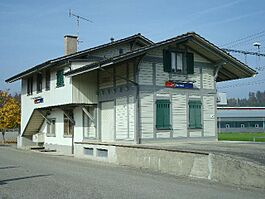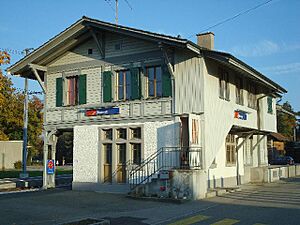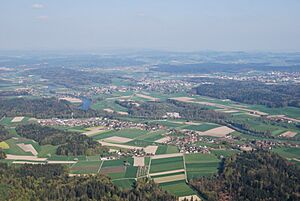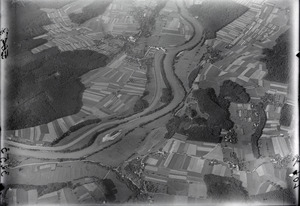Bannwil facts for kids
Quick facts for kids
Bannwil
|
||
|---|---|---|

Historic Bannwil train station
|
||
|
||
| Country | Switzerland | |
| Canton | Bern | |
| District | Oberaargau | |
| Area | ||
| • Total | 4.78 km2 (1.85 sq mi) | |
| Elevation | 434 m (1,424 ft) | |
| Population
(Dec 2020 )
|
||
| • Total | 676 | |
| • Density | 141.42/km2 (366.3/sq mi) | |
| Postal code |
4913
|
|
| Surrounded by | Aarwangen, Berken, Graben, Niederbipp, Oberbipp, Schwarzhäusern, Walliswil bei Niederbipp | |
Bannwil is a small town, also called a municipality, located in the Oberaargau area of the canton of Bern in Switzerland. It's a place with a long history and a strong connection to the Aare river.
Contents
History of Bannwil
Bannwil was first mentioned in official records way back in 1262. It was called Benwile then.
The area around Bannwil has been home to people for a very long time. People lived here during the Hallstatt era, which was an important time in the Iron Age. They also lived here in the Early Middle Ages.
During the Middle Ages, Bannwil was part of a local court system called the "low court" of Aarwangen. It was also part of the larger Buchsgau district court. These courts slowly came under the control of Bern starting in 1432. By 1463, Bern fully controlled them.
For many years, Bannwil moved between different administrative areas called "bailiwicks." These were like local government districts. Finally, in the 1600s, it became a permanent part of the Aarwangen bailiwick.
The Village Church
The church in Bannwil was first mentioned in 1304. The building you see today was built in 1522. It was later rebuilt in 1679.
In 1320, a powerful family, the Count of Frohburg, gave control of the church to the Schöntal monastery. Later, in 1528, control of the church was given to Bern.
Modern Developments
In 1904, a hydroelectric power plant opened in Bannwil. This plant used the power of water to create electricity. It was replaced in 1970 by a newer, more modern plant called the Aarekraftwerk-Bannwil.
A big change happened in 1907 when the Langenthal-Niederbipp railroad line was built through Bannwil. This train line made it much easier to travel to and from the municipality. It allowed people to live in Bannwil and travel to jobs in other towns. By 1990, more than half of the people working in Bannwil traveled outside the town for their jobs.
Geography of Bannwil
Bannwil covers an area of about 4.8 square kilometers (1.9 square miles). A large part of this land, about 45.9%, is used for farming. Forests cover about 39.2% of the area.
About 8.8% of Bannwil's land is covered by buildings and roads. Rivers and lakes make up 5.0% of the area. Only a tiny part, 0.2%, is unproductive land that cannot be used for farming or building.
Most of the built-up areas are homes and other buildings (4.8%). Roads and other transport paths make up 2.3%. In the forested areas, 37.2% is dense forest, and 2.1% has smaller groups of trees or orchards. For farming, 33.6% is used for growing crops, and 10.9% is used for pastures where animals graze.
Bannwil is located on the left side of the Aare river. The municipality includes several small villages and areas. These are Bannwil, Stalden, Winkel, Bännli, and Hogerrüti.
In 2010, Bannwil joined a new administrative area called Verwaltungskreis Oberaargau. This happened after its old district, Amtsbezirk Aarwangen, was closed.
Bannwil's Coat of Arms
The blazon (official description) of Bannwil's coat of arms is: Gules a Trefoil Vert topped with a Mullet of Five Or. This means it shows a green three-leaf clover with a gold five-pointed star above it, all on a red background.
Population of Bannwil
Bannwil has a population of 676 people (as of December 2020). About 6.7% of the people living in Bannwil are foreign nationals. Over the last ten years (from 2000 to 2010), the population grew by 1.5%. Most of this growth came from people moving into the town.
Languages Spoken
Most people in Bannwil speak German as their main language. In 2000, about 96.5% of the population spoke German. The next most common languages were Serbo-Croatian (1.3%) and Albanian (1.1%). A few people also spoke French or Italian.
Who Lives in Bannwil?
As of 2008, the population was almost evenly split between males (49.9%) and females (50.1%). Most residents are Swiss citizens.
In 2000, about 32.2% of the people living in Bannwil were born there. Another 39.6% were born in the same canton (Bern). About 19.2% were born elsewhere in Switzerland, and 6.8% were born outside of Switzerland.
Age Groups
In 2010, children and teenagers (ages 0–19) made up 21.5% of the population. Adults (ages 20–64) were the largest group, at 61.2%. Seniors (over 64 years old) made up 17.2% of the population.
Population Changes Over Time
The chart below shows how Bannwil's population has changed throughout history:

Economy of Bannwil
In 2011, Bannwil had a low unemployment rate of 1.15%. This means most people who wanted jobs had them. In 2008, there were 213 people working in the municipality.
Main Job Sectors
Jobs in Bannwil are divided into three main groups:
- Primary Sector: This includes jobs related to farming, fishing, and forestry. In 2008, 45 people worked in this sector, with about 15 businesses.
- Secondary Sector: This involves manufacturing and construction. There were 71 people working in this sector, with 10 businesses. Most of these jobs (84.8%) were in manufacturing.
- Tertiary Sector: This includes jobs in services, like shops, transport, and education. In 2008, 97 people worked in this sector, with 18 businesses. Many jobs were in transport (47.7%) and sales (15.9%).
Commuting and Transport
In 2000, 36 workers traveled into Bannwil for their jobs. However, 235 workers traveled out of Bannwil to work in other places. This means many people who live in Bannwil work outside the municipality.
About 12% of working people used public transportation to get to work. Most people (59.8%) used a private car. The Bannwil railway station is an important part of the Langenthal-Oensingen train line.
Religion in Bannwil
Based on the 2000 census, most people in Bannwil are Christian. About 73.8% belonged to the Swiss Reformed Church, which is a Protestant church. Another 12.2% were Roman Catholic.
A smaller number of people belonged to other Christian churches, including Orthodox and Christian Catholic. About 2.2% of the population was Islamic. There were also a few Buddhists. About 4.08% of the population did not belong to any church.
Education in Bannwil
Education is important in Bannwil. About 44.6% of the population has finished non-mandatory upper secondary education. This is like high school or vocational training. About 11.1% have gone on to higher education, like a university or a specialized college.
School System
The Canton of Bern has a specific school system:
- Kindergarten: One year of non-required kindergarten.
- Primary School: Six years of primary school.
- Lower Secondary School: Three years of required secondary school. Students are grouped based on their abilities.
After lower secondary school, students can choose to continue their education or start an apprenticeship (on-the-job training).
Students in Bannwil
During the 2009-10 school year, 53 students attended classes in Bannwil.
- There was one kindergarten class with 14 students. A small number of these students were not Swiss citizens or had a different first language.
- There were two primary classes with 39 students. Again, a small number were not Swiss citizens or had a different first language.
In 2000, 6 students came to Bannwil to attend school. At the same time, 29 students from Bannwil went to schools in other towns.
See also
 In Spanish: Bannwil para niños
In Spanish: Bannwil para niños







